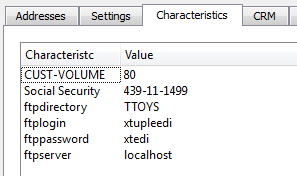
|
xTuple Connect Product Guide |
Now that we have a rather generic EDI Profile, we have to set up the Customers to use this Profile. There are several ways we can do this. We've chosen to store the FTP connection information in Customer Characteristics. To take this approach we must do the following:
Create the Characteristics
Define values for these characteristics for each Customer
Attach the EDI Profile to each Customer for all three Document Types
If you read the query in the previous section, you'll know that it looks for four Characteristics associated with the Customer: ftpserver, ftplogin, ftppassword, and ftpdirectory. These do not yet exist in the database, so we have to add them:
Follow this path:
Click the NEW button
In the "Name" field, enter "ftpserver"
Check the "Customer" field
In the "Description" field, enter "Used for EDI Profiles"
Click the SAVE button
Repeat these steps to create the other three Characteristics that we need: "ftplogin", "ftppassword", and "ftpdirectory".
To send FTP to your Customers, you'll need to get the address for their FTP servers, either a host name (e.g., ftp.xtuple.com) or an IP address (e.g., 192.168.57.122), and a user name and password. You might also get a directory name in which to put the transferred files. In the example below, we'll use "localhost" for the FTP server, "xtedi" for the login and password, and the Customer Number for the directory.
The process to set up the Characteristics and enter values for each Customer depends on whether your Customers have a Customer Type that Enables Characteristics Profiles or not. For Customers who have Characteristics Profiles enabled, first follow these steps to add the Characteristics to the Characteristic Profile:
Follow this path:
Select a Customer Type with Enabled Characteristics Profiles (e.g. "NORMAL")
Click the EDIT button
Set the "Characteristic" field to "ftpserver"
Click the Save button
Repeat for "ftplogin", "ftppassword", and "ftpdirectory"
Click the SAVE button on the Customer Type window
Next, set the individual Characteristic values for each Customer you want to send EDI to. Follow these steps to do so:
Follow this path:
Select one of your Customers from the list that has the Customer Type you just edited (e.g. TTOYS)
Click the EDIT button
Click on the "Characteristics" tab
Double-click on the "Value" column of the "ftpserver" row
Type "localhost"
Double-click on the "Value" column of the "ftplogin" row
Type "xtedi"
Double-click on the "Value" column of the "ftppassword" row
Type "xtedi"
Double-click on the "Value" column of the "ftpdirectory" row
Type the Customer Number (e.g. "TTOYS")
At this point, the Characteristics tab of the Customer window should look like this:

Sample settings of Customer Characteristics for FTP EDI
Repeat this last set of steps for every Customer you want to set up to use the FTP EDI Profile just created. The process for adding Characteristics to a Customer without the Enable Characteristics Profiles limitation is much simpler. See the xTuple ERP Reference Guide for more information.
The final configuration step is to attach the EDI Profile to each Customer. This ensures that the system finds the right EDI Profile and sends the right data in the right format whenever sending EDI for this Customer. Customers who do not have EDI Profiles defined will not receive any EDI (with the exception of Incident EDI if the CRM module is configured to send EDI for Incidents).
To attach the EDI Profile we created to a Customer, follow these steps:
Follow this path:
Select one of the Customers you set the FTP Characteristics for from the list of Customers (e.g., TTOYS)
Click on the "Transmission" tab
Click the ATTACH button
The "Attach EDI Profile" window will open
Set the "Document Type" to "Invoice"
The default behavior for the "Attach EDI Profile" window is to show only EDI Profiles that have an EDI Form for the selected Document Type. If you want to select a different EDI Profile, click on the SHOW ALL EDI PROFILES check box and select that from the list.
Just remember that you will have to go back and add a new EDI Form to that EDI Profile for the selected Document Type or EDI will not get sent properly.
Select "Sales_FTP_CSV" from the list
Click the ATTACH button
Repeat steps 4-8 for "Sales Order" and "Quote"
Repeat steps 2-9 for another Customer
You're now done with your EDI configuration!